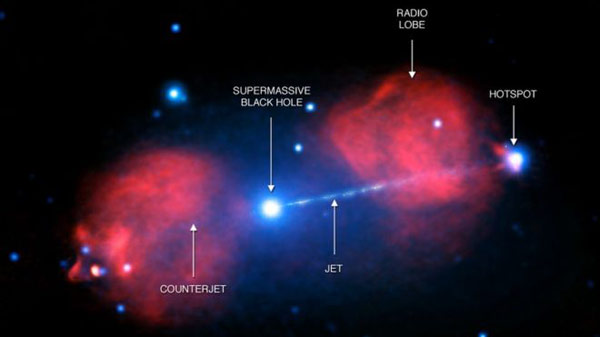
Hertfordshire, UK (BBN)-Astronomers have published new images of a bright jet of material, long enough to cross the Milky Way three times, fired into space by the black hole at the heart of a distant galaxy.
The observations confirm the existence of a second jet, blasting in the opposite direction, reports, BBC.
The study uses this galaxy, Pictor A, to test ideas about what makes jets like these emit very bright X-rays.
It appears in the Monthly Notices of the Royal Astronomical Society.
To make their observations, the team combined 15 years of X-ray data, from Nasa's Chandra space telescope, with images taken in radio wavelengths by the Australia Telescope Compact Array.
Chandra has been in orbit since 1999 - and interest in Pictor A was sparked right back at the beginning of its mission, according to Martin Hardcastle from the University of Hertfordshire, UK.
"The early images from Chandra showed there was this very bright jet," Prof Hardcastle, the study's lead author, told the BBC.
"At that stage we didn't really understand it, because the data were good enough to make an image of the jet, but not to do this kind of detailed analysis."
The new images have five or six times the resolution of our previous best views of Pictor A, he added, meaning that new features can be detected and the physics of the jet probed in detail.
BLOWING UP BALLOONS
Most big galaxies have a supermassive black hole at their centre, and Pictor A - five million light-years from Earth - is no exception.
In its case, the immense quantities of stuff swirling towards the black hole release so much energy that a beam of high-energy particles is spat across space, at very nearly light speed.
A second jet, fired in the opposite direction, was only an indistinct shadow in previous images, Prof Hardcastle said.
"In some work we did on an interim version of this data set, we thought we could see it. But now it's definitely there."
This "counterjet" - to the left in the blue X-ray image - appears much fainter than its twin and the team believes this is because it is moving away from us, at the same breakneck speed.
According to the principles of relativity, this makes it look dimmer.
"It's like the Doppler effect only more so," said Prof Hardcastle.
"In special relativity it actually effects the amplitude as well as the frequency of the emission."
Blooming outwards from the twin beams are two clouds of hot material, clearly visible in the radio wave images (displayed in red in these images).
Everywhere you see light, you've got some sort of process... dumping [energy] into those electrons.
We don't know what that is.
Prof Martin Hardcastle, University of Hertfordshire
These are created after the jets smash into the sparse, gaseous medium that separates galaxies.
"The material goes up the jet at relativistic speeds and at some point it runs into the external medium. And when it does, it's like blowing up a balloon; the material that's come up the jet has to go somewhere and it inflates these lobes," Prof Hardcastle said.
"It's basically pushing the hot intergalactic medium out of the way, so it blows these twin bubbles."
At the end of the jet there is also a "hotspot", visible in both images, where the material first piles up in collision with that medium.
MYSTERIOUS ACCELERATION
The most intriguing problem for Prof Hardcastle and his colleagues, however, is wrapped up in the jet itself.
"The question for us is, why can you see the jet at all? It's these very fast chunks of material, but why are they radiating?"
Based on their observations, they say one previous explanation - based on jet particles bouncing off the cosmic microwave background - can be discarded.
Instead, the light we can see shining from the twin jets is apparently produced by electrons spinning around in very small circles.
Just like what happens when electrons are piped around in much bigger circles in a synchrotron, here on Earth, that motion produces radiation in the form of bright X-rays.
But a mystery remains, because the electrons must be re-accelerated along the length of the jet; the mighty shove delivered back at the black hole is not enough.
"Everywhere you see light, you've got some sort of process that's taking energy out of the jet and dumping it into those very high-energy electrons," Prof Hardcastle said.
"We don't know what that is. But we can study the process in Pictor A much better than anywhere else."
BBN/TR/AD